Abstract
In efforts to prepare more potent and sensitive viral serological antigens, several aspects of the production of antigens from infected cell cultures were studied. Antigens derived from whole, infected culture material and from the cellular and fluid phases were compared. Freezing and thawing, sonication, and alkaline buffer extraction were compared for effectiveness in releasing antigen from host cells. The effect of the multiplicity of infection on titers of viral antigens produced in cell cultures was studied. Generally, higher titered antigens were derived from the infected cells than from the culture fluids, but for certain viruses complement-fixing (CF) antigens derived from the culture fluids gave higher antibody titers than did cell-associated antigens. With each virus-host cell system studied, treatment with alkaline buffers extracted appreciable amounts of CF antigen from the host cells, but in some instances more antigen was released by freezing and thawing or by sonication. Extraction of infected cells with alkaline buffers was not a satisfactory method for preparation of hemagglutinating (HA) antigens for any of the viruses studied. The highest-titered HA antigens were produced from infected cells disrupted by freezing and thawing or sonication. The highest titered CF and HA antigens were produced from cell cultures infected at multiplicities of one or greater. Complement-fixing antigens produced by infecting cells in suspension and then planting had lower titers than antigens produced in parallel by infecting developed monolayers. Optimal methods are summarized for preparation of serological antigens to a variety of viruses of man.
Full text
PDF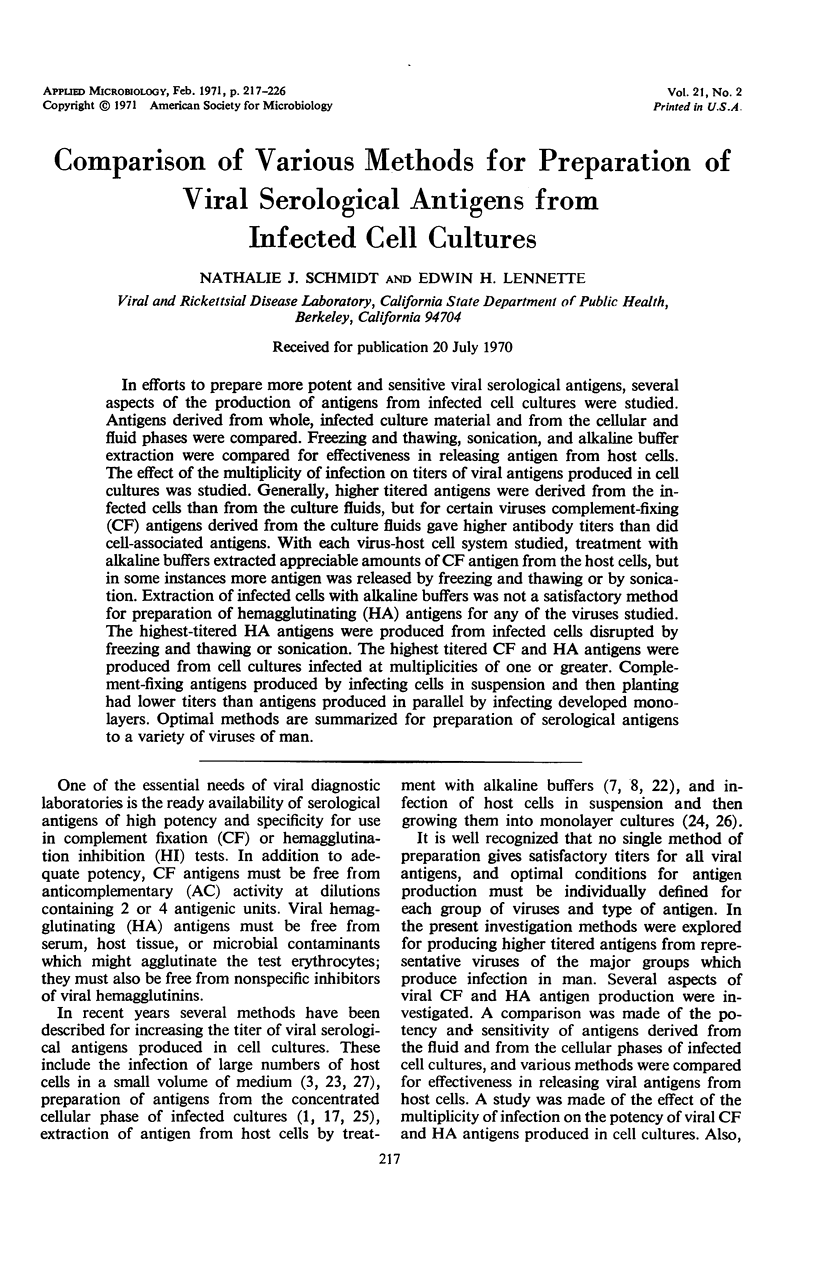
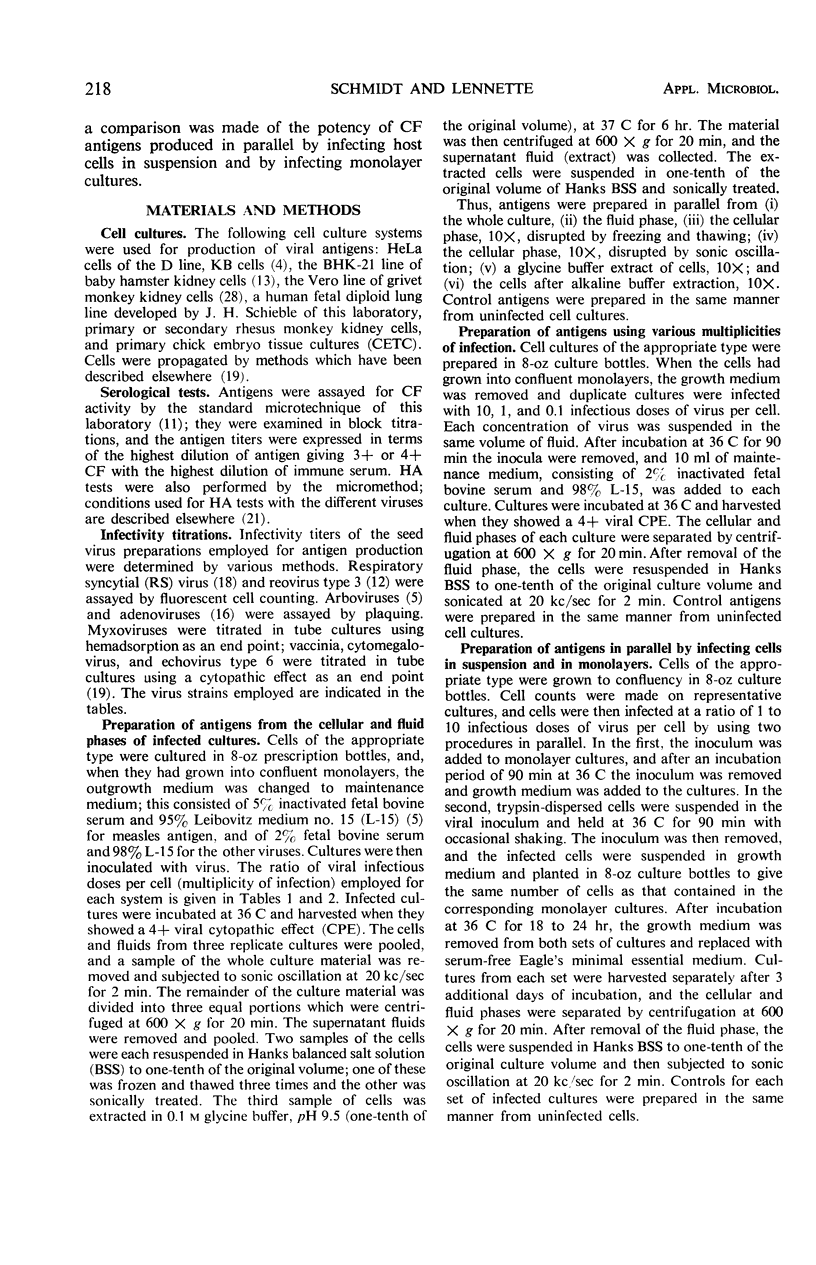
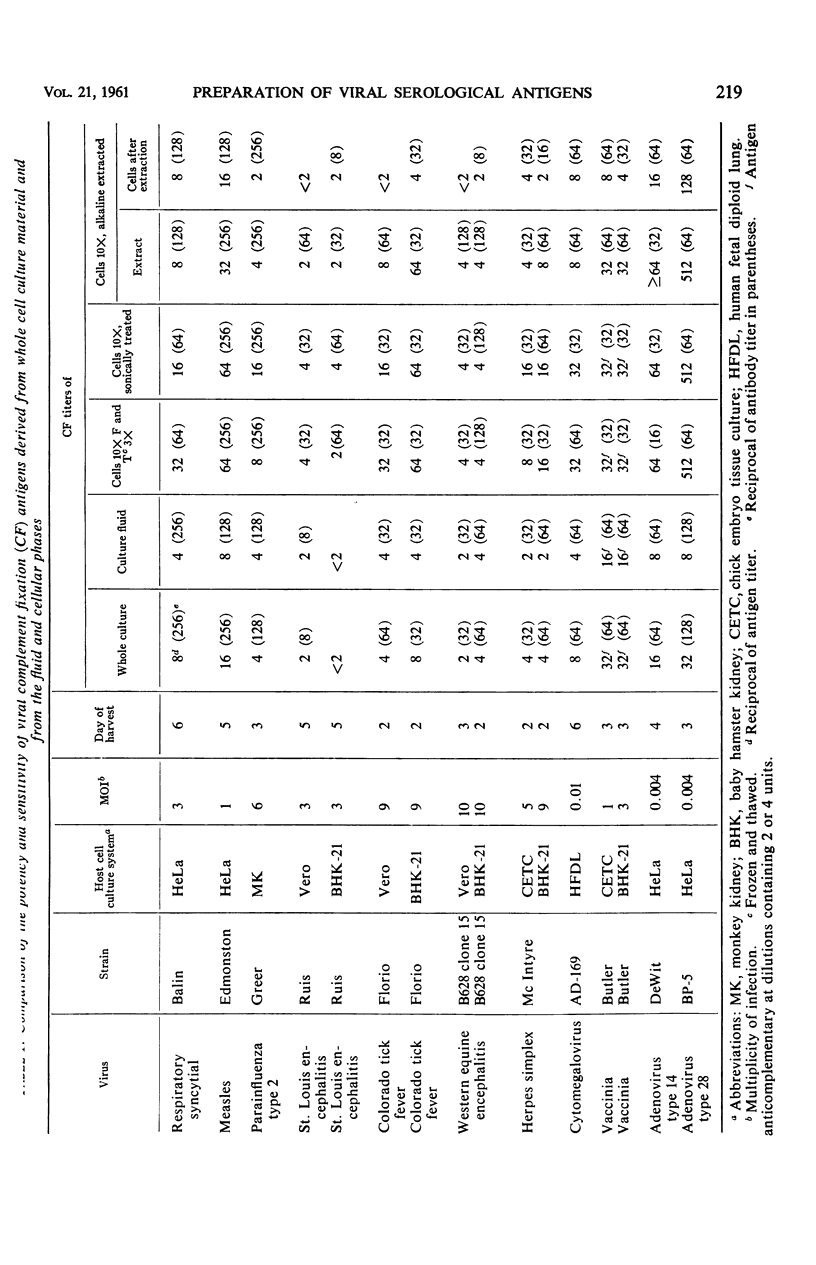
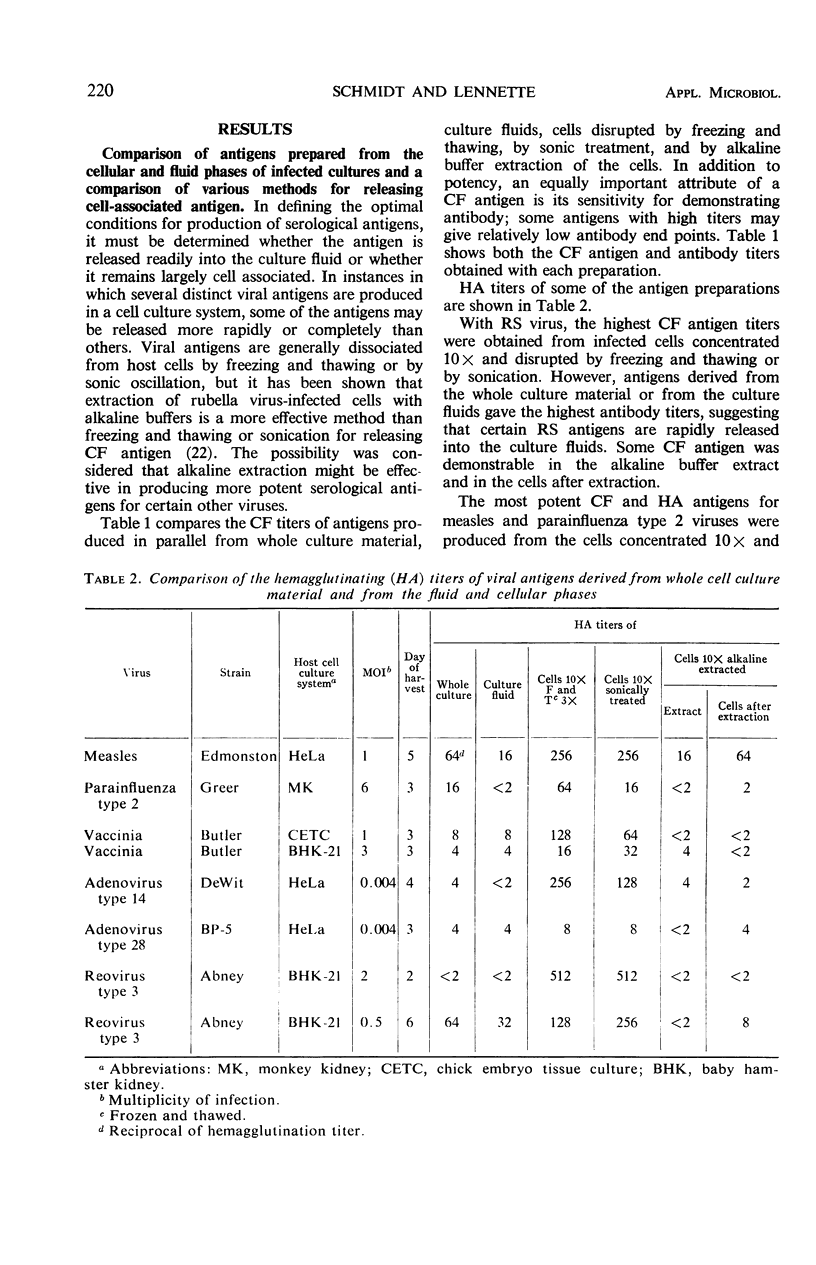
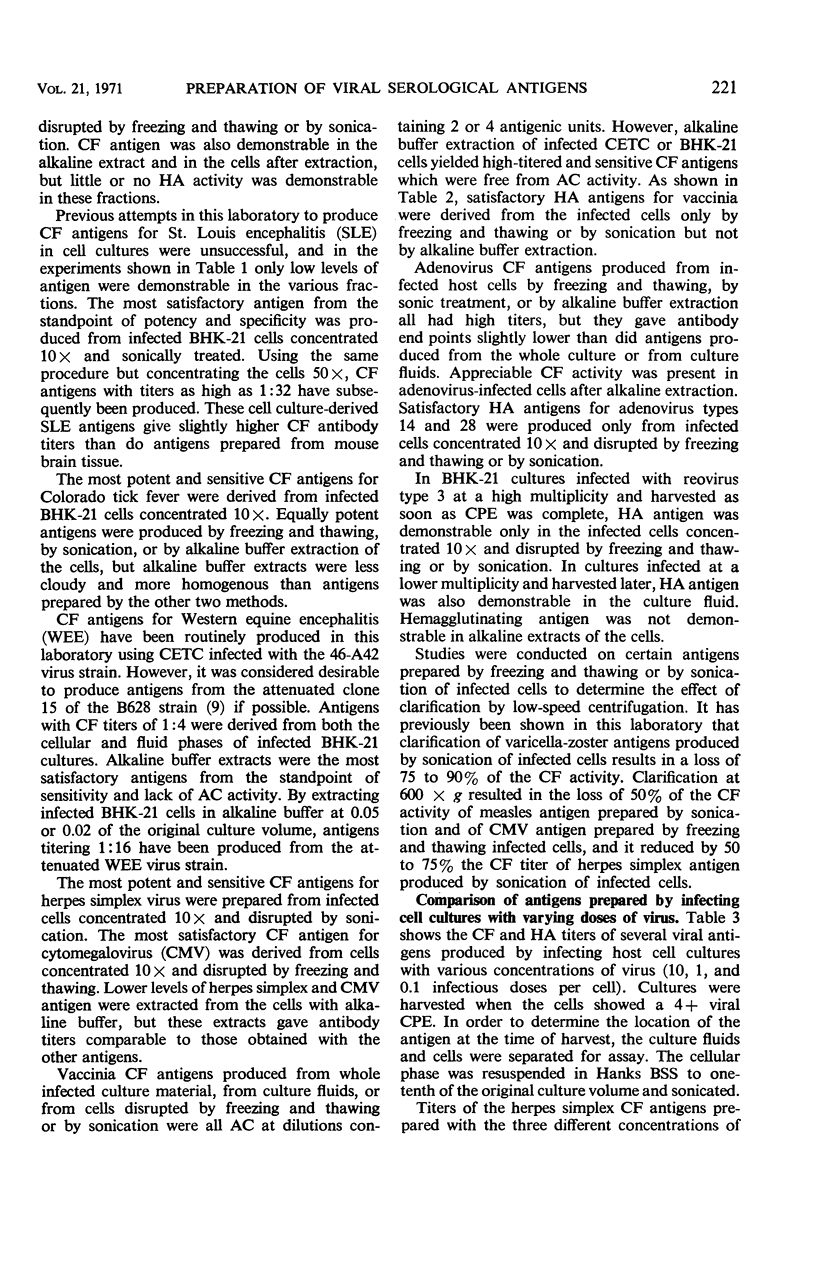
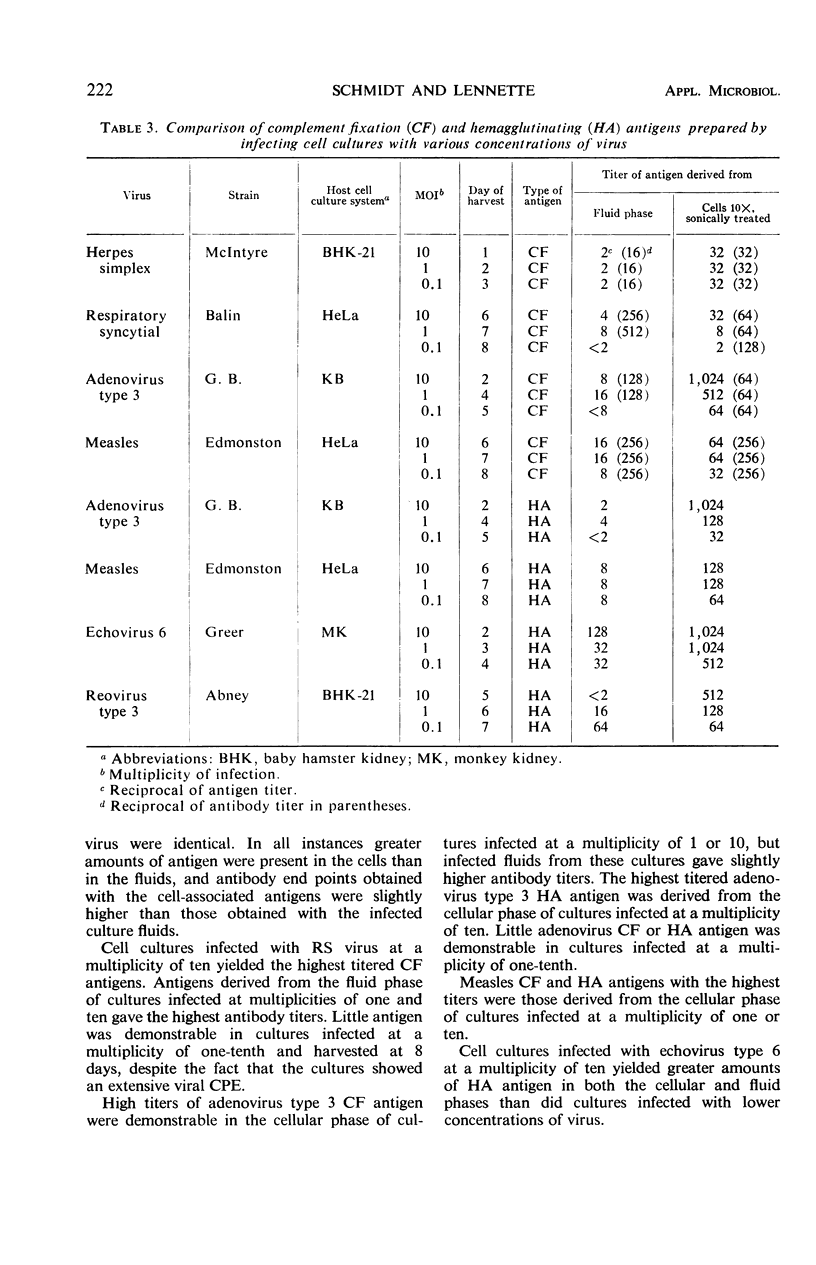
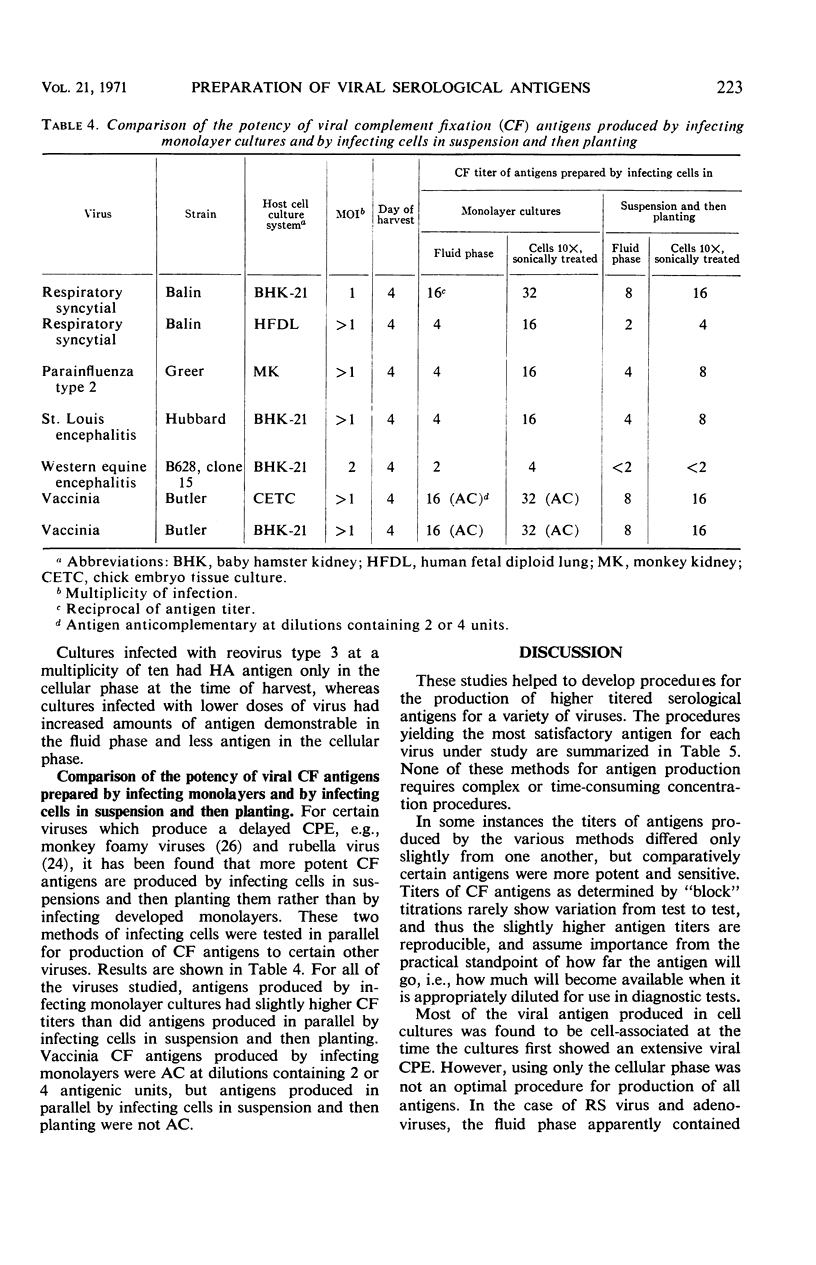
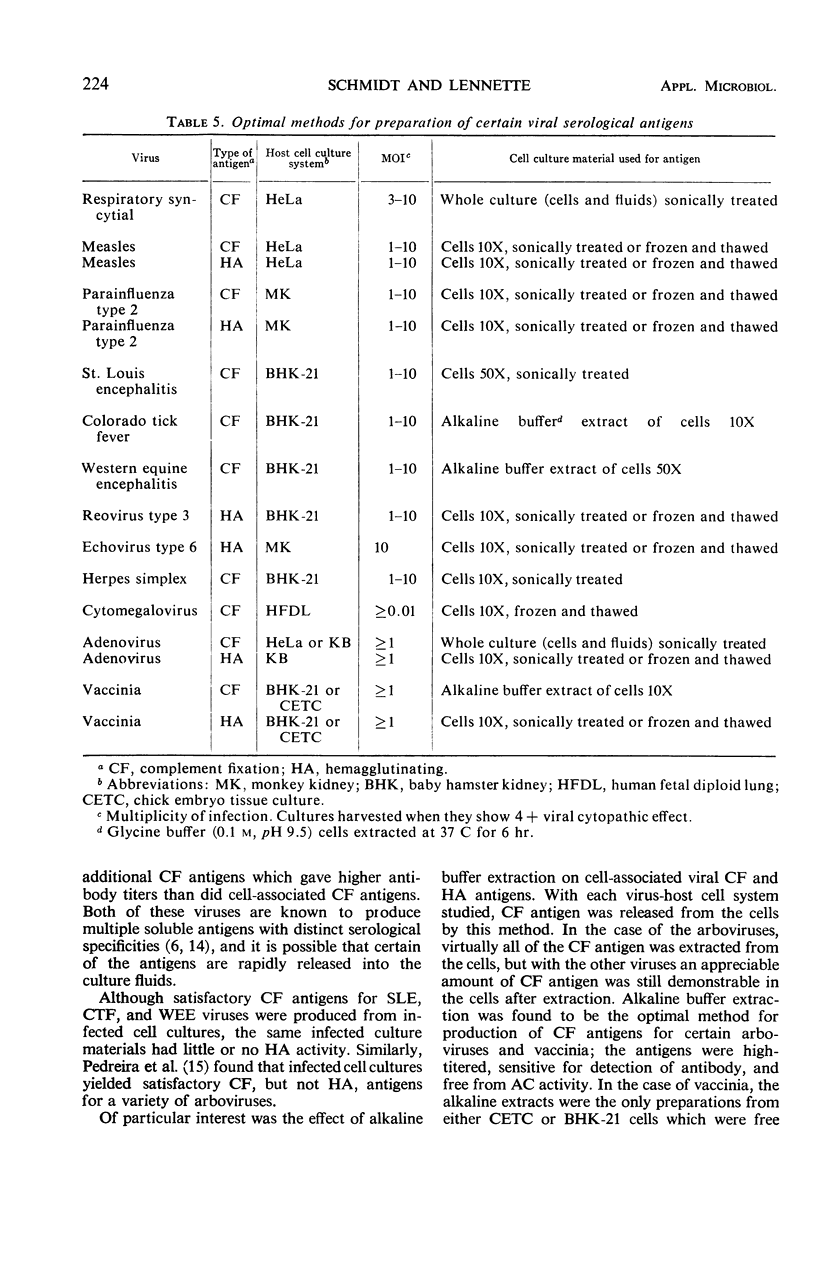
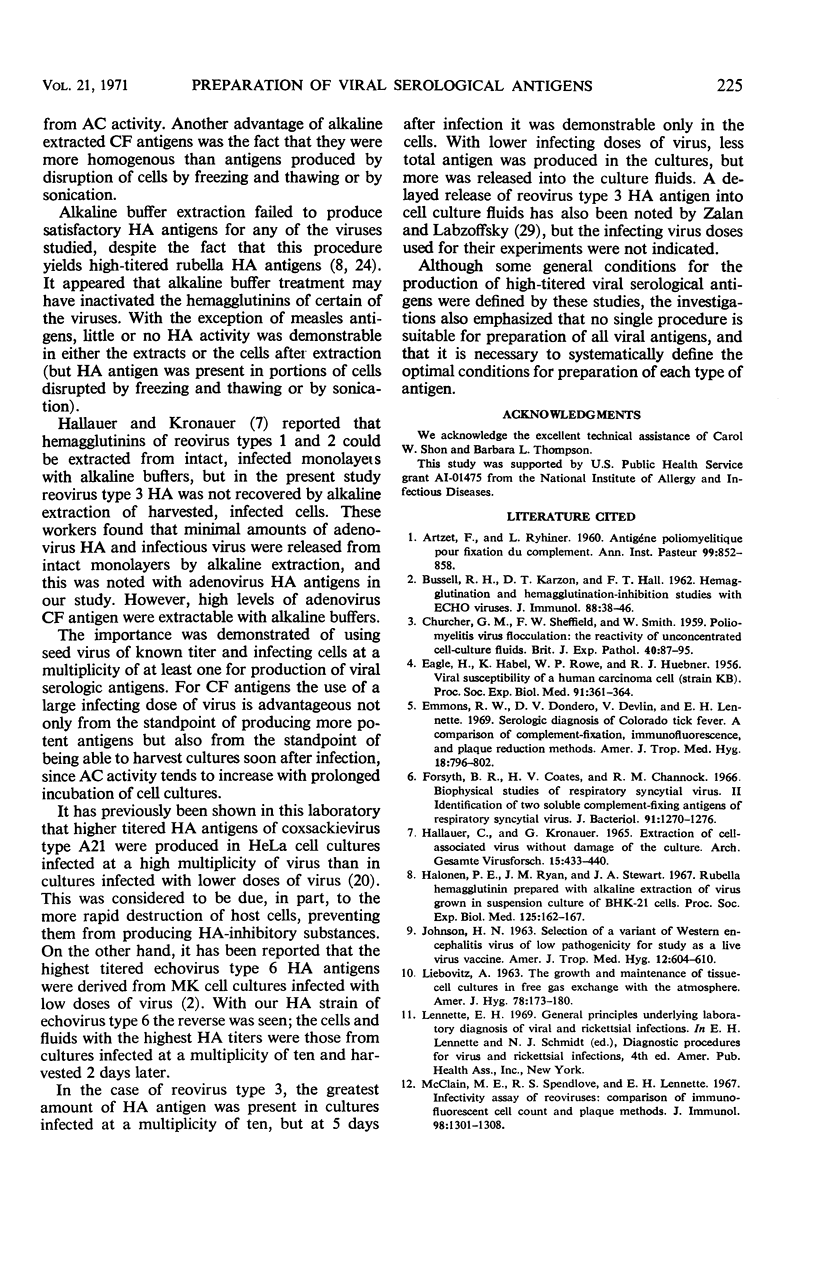
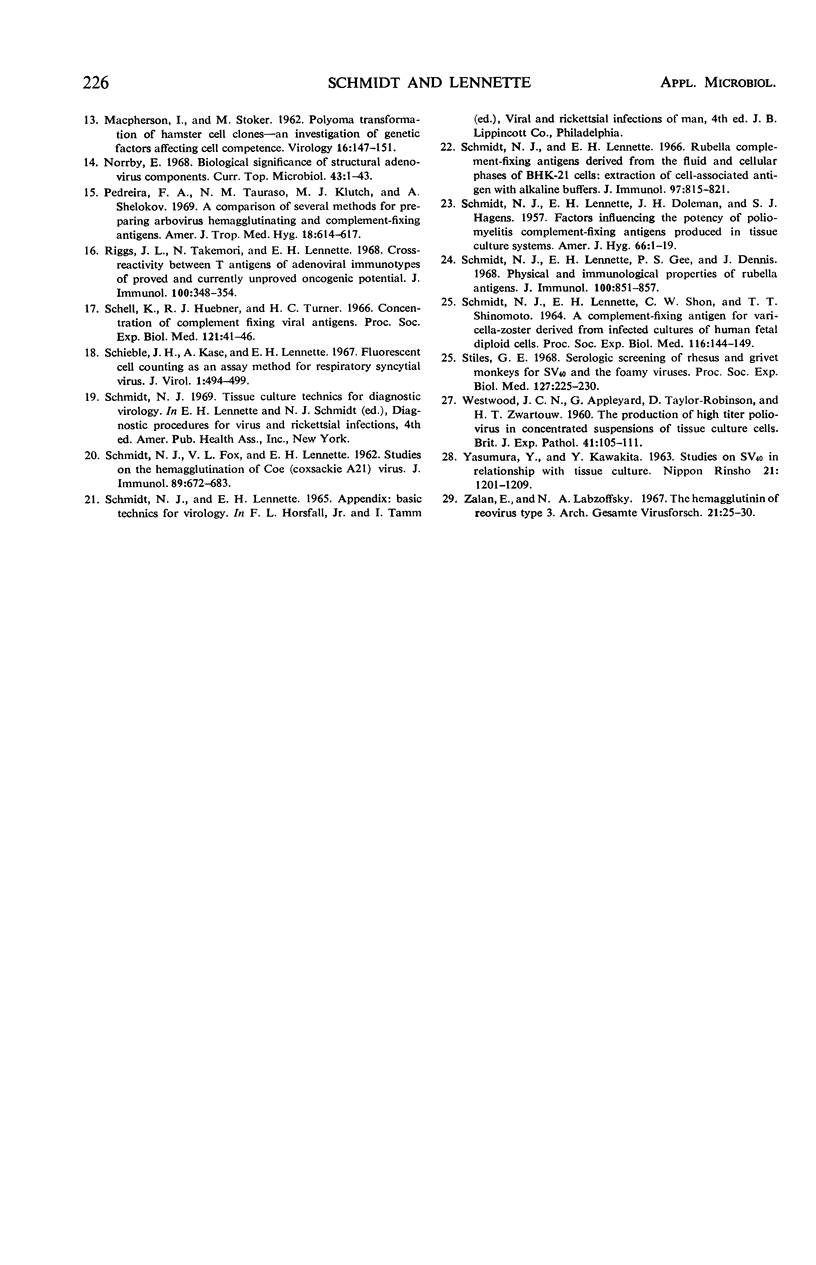
Selected References
These references are in PubMed. This may not be the complete list of references from this article.
- ARTZET F., RYHINER L. [Poliomyelitic antigen for complement fixation]. Ann Inst Pasteur (Paris) 1960 Dec;99:852–858. [PubMed] [Google Scholar]
- BUSSELL R. H., KARZON D. T., HALL F. T. Hemagglutination and hemagglutination-inhibition studies with ECHO viruses. J Immunol. 1962 Jan;88:38–46. [PubMed] [Google Scholar]
- CHURCHER G. M., SHEFFIELD F. W., SMITH W. Poliomyelitis virus flocculation: the reactivity of unconcentrated cell-culture fluids. Br J Exp Pathol. 1959 Feb;40(1):87–95. [PMC free article] [PubMed] [Google Scholar]
- EAGLE H., HABEL K., ROWE W. P., HUEBNER R. J. Viral susceptibility of a human carcinoma cell (strain KB). Proc Soc Exp Biol Med. 1956 Mar;91(3):361–364. doi: 10.3181/00379727-91-22263. [DOI] [PubMed] [Google Scholar]
- Emmons R. W., Dondero D. V., Devlin V., Lennette E. H. Serologic diagnosis of Colorado tick fever. A comparison of complement-fixation, immunofluorescence, and plaque-reduction methods. Am J Trop Med Hyg. 1969 Sep;18(5):796–802. doi: 10.4269/ajtmh.1969.18.796. [DOI] [PubMed] [Google Scholar]
- Forsyth B. R., Coates H. V., Chanock R. M. Biophysical studies of respiratory syncytial virus. II. Identification of two soluble complement-fixing antigens of respiratory syncytial virus. J Bacteriol. 1966 Mar;91(3):1270–1276. doi: 10.1128/jb.91.3.1270-1276.1966. [DOI] [PMC free article] [PubMed] [Google Scholar]
- HALLAUER C., KRONAUER G. EXTRACTION OF CELL-ASSOCIATED VIRUS WITHOUT DAMAGE OF THE CULTURE. (BRIEF REPORT). Arch Gesamte Virusforsch. 1965;15:433–440. doi: 10.1007/BF01241771. [DOI] [PubMed] [Google Scholar]
- Halonen P. E., Ryan J. M., Stewart J. A. Rubella hemagglutinin prepared with alkaline extraction of virus grown in suspension culture of BHK-21 cells. Proc Soc Exp Biol Med. 1967 May;125(1):162–167. doi: 10.3181/00379727-125-32038. [DOI] [PubMed] [Google Scholar]
- LEIBOVITZ A. THE GROWTH AND MAINTENANCE OF TISSUE-CELL CULTURES IN FREE GAS EXCHANGE WITH THE ATMOSPHERE. Am J Hyg. 1963 Sep;78:173–180. doi: 10.1093/oxfordjournals.aje.a120336. [DOI] [PubMed] [Google Scholar]
- MACPHERSON I., STOKER M. Polyoma transformation of hamster cell clones--an investigation of genetic factors affecting cell competence. Virology. 1962 Feb;16:147–151. doi: 10.1016/0042-6822(62)90290-8. [DOI] [PubMed] [Google Scholar]
- McClain M. E., Spendlove R. S., Lennette E. H. Infectivity assay of Reoviruses: comparison of immunofluorescent cell count and plaque methods. J Immunol. 1967 Jun;98(6):1301–1308. [PubMed] [Google Scholar]
- Norrby E. Biological significance of structural adenovirus components. Curr Top Microbiol Immunol. 1968;43:1–43. doi: 10.1007/978-3-642-46118-7_1. [DOI] [PubMed] [Google Scholar]
- Pedreira F. A., Tauraso N. M., Klutch M. J., Shelokov A. A comparison of several methods for preparing arbovirus hemagglutinating and complement-fixing antigens. Am J Trop Med Hyg. 1969 Jul;18(4):614–617. doi: 10.4269/ajtmh.1969.18.614. [DOI] [PubMed] [Google Scholar]
- Riggs J. L., Takemori N., Lennette E. H. Cross-reactivity between T antigens of adenoviral immunotypes of proved and currently unproved oncogenic potential. J Immunol. 1968 Feb;100(2):348–354. [PubMed] [Google Scholar]
- SCHMIDT N. J., FOX V. L., LENNETTE E. H. Studies on the hemagglutination of Coe (Coxsackie A21) virus. J Immunol. 1962 Nov;89:672–683. [PubMed] [Google Scholar]
- SCHMIDT N. J., LENNETTE E. H., DOLEMAN J. H., HAGENS S. J. Factors influencing the potency of poliomyelitis complement-fixing antigens produced in tissue-culture systems. Am J Hyg. 1957 Jul;66(1):1–19. doi: 10.1093/oxfordjournals.aje.a119879. [DOI] [PubMed] [Google Scholar]
- SCHMIDT N. J., LENNETTE E. H., SHON C. W., SHINOMOTO T. T. A COMPLEMENT-FIXING ANTIGEN FOR VARICELLA-ZOSTER DERIVED FROM INFECTED CULTURES OF HUMAN FETAL DIPLOID CELLS. Proc Soc Exp Biol Med. 1964 May;116:144–149. doi: 10.3181/00379727-116-29184. [DOI] [PubMed] [Google Scholar]
- Schell K., Huebner R. J., Turner H. C. Concentration of complement fixing viral antigens. Proc Soc Exp Biol Med. 1966 Jan;121(1):41–46. doi: 10.3181/00379727-121-30692. [DOI] [PubMed] [Google Scholar]
- Schieble J. H., Kase A., Lennette E. H. Fluorescent cell counting as an assay method for respiratory syncytial virus. J Virol. 1967 Jun;1(3):494–499. doi: 10.1128/jvi.1.3.494-499.1967. [DOI] [PMC free article] [PubMed] [Google Scholar]
- Schmidt N. J., Lennette E. H., Gee P. S., Dennis J. Physical and immunologic properties of rubella antigens. J Immunol. 1968 Apr;100(4):851–857. [PubMed] [Google Scholar]
- Schmidt N. J., Lennette E. H. Rubella complement-fixing antigens derived from the fluid and cellular phases of infected BHK-21 cells: extraction of cell-associated antigen with alkaline buffers. J Immunol. 1966 Dec;97(6):815–821. [PubMed] [Google Scholar]
- Stiles G. E. Serologic screening of rhesus and grivet monkeys for SV40 and the foamy viruses. Proc Soc Exp Biol Med. 1968 Jan;127(1):225–230. doi: 10.3181/00379727-127-32662. [DOI] [PubMed] [Google Scholar]
- WESTWOOD J. C., APPLEYARD G., TAYLOR-ROBINSON D., ZWARTOUW H. T. The production of high titre poliovirus in concentrated suspensions of tissue culture cells. Br J Exp Pathol. 1960 Apr;41:105–111. [PMC free article] [PubMed] [Google Scholar]
- Zalan E., Labzoffsky N. A. The hemagglutinin of reovirus type 3. Arch Gesamte Virusforsch. 1967;21(1):25–30. doi: 10.1007/BF01258473. [DOI] [PubMed] [Google Scholar]


